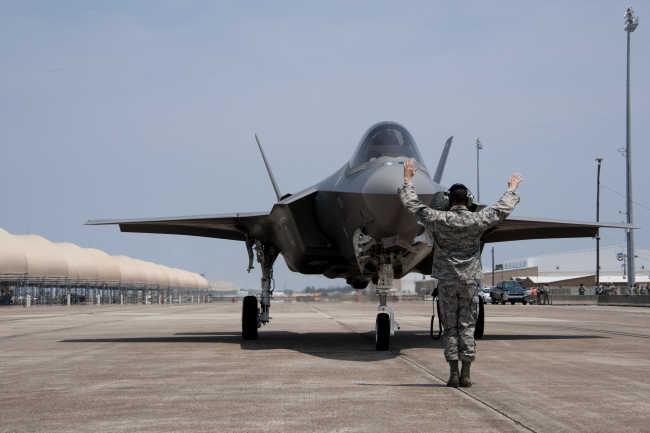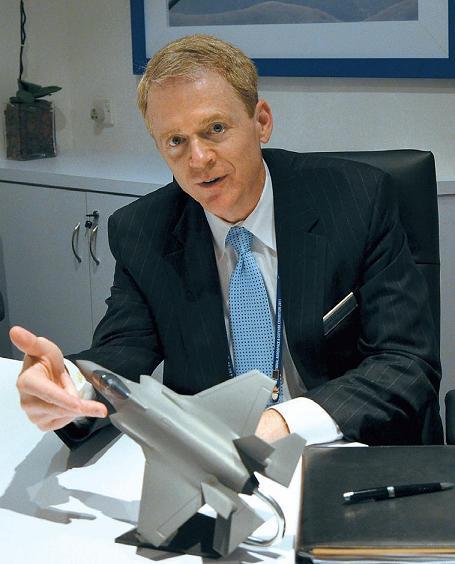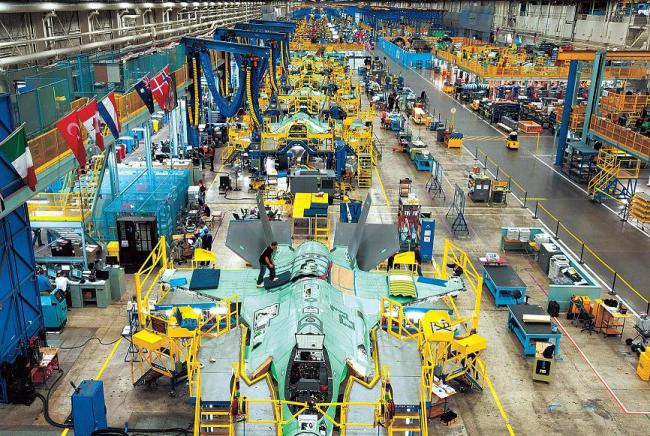Seoul faces tough choice in fighter procurement
Lockheed Martin hints at less than $125m price tag for Korea, confident of F-35’s delivery time
By Korea HeraldPublished : March 27, 2013 - 20:44
But that confidence has been eroded by the discovery of defects, surging costs and delays in its development.
Skepticism has grown in the U.S. over the $60 billion acquisition program, with some deriding it as a money-guzzling project kept alive partly due to the more than 130,000 U.S. manufacturing jobs that depend on it.
This has spawned concerns in South Korea. In addition to U.S. budgetary problems that could lead to delayed or canceled orders, any trouble in the F-35 program might influence Seoul’s fighter procurement in terms of unit price, capabilities and delivery time.

The F-35’s Air Force variant is one of the three competitors for Seoul’s FX project to purchase a high-end, yet affordable fleet of 60 combat aircraft and start deploying them in 2016.
Boeing’s F-15 Silent Eagle and the Eurofighter Typhoon of the European Aeronautic Defense and Space Company N.V. are the other candidates. Seoul’s choice is expected to be made mid-year.
Dave Scott, director of Lockheed Martin’s F-35 International Business Development, dismissed the deteriorating sentiment over the radar-evading plane, saying the F-35 would be delivered on schedule. He also stressed Seoul would be the “beneficiary” of the investment the U.S. and eight partner nations have made in the program since 2001.
“We have sufficient capability to build and deliver those airplanes (for South Korea). We are in the process of increasing (the production) capacity as we increase orders and deliveries,” he said during an interview with the Korean press contingent at the LM factory in Fort Worth, Texas, last week.


Scott also moved to counter the recent news reports over the unit prices.
Some said the unit price for the F-35 would be around $190 million, which would make it impossible for Korea to meet its 8.3 trillion won ($7.48 billion) procurement goal.
“The cost of the A-model (air force version) in the fifth production lot (in 2013) is approximately $125 million. Korea will be buying potentially three years later for their initial buy,” he said.
“So you can have an idea that we are already well below any of the numbers that are being discussed in terms of our actual contract today with the U.S. government.”
The conventional takeoff and landing F-35A is for air force operations, while the F-35B is the Marine Corps’ short take-off and vertical landing variant and the F-35C is the Navy’s carrier-based version. The F-35B and C models are more expensive.
Scott emphasized that 2016, when Korea wants to start bringing in its first batch, would be exactly on the “sweet spot of the cost curve” as mass production in that year would bring down the price.
Within the next several weeks prior to making a price proposal to Seoul, Lockheed will notify Congress of the F-35 program price for Korea. It will not be only a unit price, but a “cost ceiling” that includes support systems, spares and training, he said.
“That is a ceiling amount and the actual (unit) price is a subset ― part of that. The actual amount in the negotiations (with Seoul) will begin at a lower level and work down from there,” he said, urging the press not to mistake it for the airplane price.
One of the crucial challenges to the F-35 program would be the reconsideration by some of the program’s partner nations such as Denmark over their acquisition plans. What worries Korea is the possibility of cancellations by those countries increasing the price.
Scott admitted there would be an impact should there be a “substantial” change in the planned orders by the U.S. government and partner nations, while stressing U.S. and partners’ “commitments” for the F-35 program remain steadfast.
“If there was a change in the 2,443-airplane order (by the U.S.), it will occur many years into the future ― in all likelihoods, long after Korea has purchased the FX airplanes,” he stressed.
The F-35 “Joint Strike Fighter” has been co-developed with the U.S. and eight foreign partners ― Britain, Italy, the Netherlands, Turkey, Canada, Australia, Denmark and Norway ― since 2001.
Over the next three decades, the U.S. military plans to buy 1,763 F-35s for its Air Force and 680 for its Marine Corps and Navy. Lockheed estimates partner nations would buy around 700 F-35s with its forecast of up to 800 orders from other countries including Israel and Japan.
One significant factor for Seoul to consider would be the aircraft’s software and hardware capabilities that have yet to be completed and proven for actual operations.
The F-35 is about one-third through its flight test program. The software is about three years away completion.
“The F-35 is not currently ready for combat operations. It is in the final stage of tests and the initial stage of training,” said Scott. “It will reach combat capability when the U.S. services declare what they call IOC or initial operational capability. That will occur in a few years ― somewhere around 2015 or 2016.”
Other crucial things for Korea to consider are wartime interoperability with its ally U.S. forces and the sustainment cost for its lifecycle ― the next three to four decades. Noting the maintenance cost would be around 15 percent higher than that for the F-16 fighter, Lockheed Martine expressed confidence over these aspects.
“The alliance has some sort of political connotation, but I always think of it in terms of interoperability ― common tactics, operational concepts and communications links. All these things are crucial factors for Korea’s combat capability,” said Randy Howard, the director of the Korea F-35 Campaign.
Stressing the F-35 was at the beginning of its production run, Howard also pointed out that maintenance-wise, the F-35 was at an advantage. But critics have said it is hard to make the cost estimate, as no country has yet used it in operations.
“What a country doesn’t want to do is to be the last country to buy an aircraft because when their production line stops, the cost for spares goes up very significantly,” Howard said.
Technology transfer is another area Seoul has been focusing on in its FX contest as it is seeking to develop an indigenous fighter jet under the “KFX” project to replace its aging F-4 and F-5 fighters.
Along with the KFX, which is about a decade behind schedule, the FX project is an urgent task for the new South Korean government given that its Air Force has already begun experiencing a shortage of warplanes. The winning fighter was to be announced last October, but the decision was deferred amid the presidential election.
The Air Force estimates it may lack some 100 fighters in 2019 when all of the F4s and F5s will be decommissioned. The Air Force believes it needs at least 430 fighter jets of different levels to prepare for possible wartime operations ― some 100 high-end, 200 middle-end and 100 low-end fighters.
Lockheed is seen as less willing to transfer the core technology Seoul needs for its KFX project while the EADS is more keen to share its Eurofighter technology, apparently to overcome its disadvantage as a rare European competitor.
Scott expected his company to be willing to transfer some technology used for the development of the T-50 trainer jet to South Korea when the F-35 is selected.
“If the F-35 is selected, it makes sense. I feel very confident we will allow that (transfer of T-50 technology) to happen. If we are not involved, it is unlikely we would share (the technology,” he said.
With technological assistance from Lockheed Martin, Korea Aerospace Industries, South Korea’s sole aircraft maker, developed the T-50. The two firms are working together to win Washington’s roughly $10 billion project, under which some 350 trainer jets are to be purchased to replace the U.S. Air Force’s aging T-38 trainers.
Dismissing the controversy over what critics call “unstable, unreliable” stealth technology, Lockheed Martin also stressed the regional strategic environment where China, Japan and Russia are transitioning to fifth-generation stealth combat aircraft.
“Don’t forget the threat environment and the advancement being made in the surface-to-air missile systems and the development of the fifth-generation aircraft by China and Russia. (These) present serious problems to the existing fleets of F-15s, F-16s and F-18s,” said Scott.
By Song Sang-ho, Korea Herald correspondent
(sshluck@heraldcorp.com)
<관련 한글 기사>
차세대 전투기 사업, 험난한 선택
10년 전, 개발 중인 록히드 마틴의 F-35 전투기는 스텔스 성능과 차세대 전투기 기술을 갖춘 꿈의 전투기로 통했다. 그러나 최근 발생한 결함, 개발비용증가 그리고 개발지연으로 부정적 시각이 늘어나고 있다.
일부는 미국의 45개 주에 퍼져있는 13만 이상의 제조업 일자리가 걸린 사업이어서 감히 취소 못하는 “돈 흡입하는 사업”이라고 비아냥거리기도 한다. 600억불이 넘는 이 사업에 대한 부정적 시각은 한국에도 영향을 미치고 있다.
한국은 FX (차세대전투기 사업)을 추진 중인데, 후보 기종 중 하나인 F-35가 미 연방정부의 예산압박과 그 이외 다른 변수로 인해 개발 비용이 추가로 증가할 경우, 기체가격이 상승 할 수 있다는 우려의 목소리도 증가하고 있다. 일부는 한국이 F-35를 선택할 경우 2016년부터 작전 배치하는 계획에 차질이 올 수도 있다고 지적한다.
하지만 록히드 마틴의 F-35 국제사업개발 데이브 스캇 이사는 이러한 우려를 일축하며, 록히드 마틴은 전투기를 계획대로 이양할 능력이 있고 한국은 미국을 포함한 9개국이 2001년도부터 투자한 사업에 “수혜자”가 될 것이라 자신했다.
최근 대당 가격이 1억 9천억 불 이상일 것이라는 언론보도와 관련해서, 2013년도 미 정부에 대한 판매가격이 1억 2,500만 불 정도라며, 3년 후인 2016년도에 전투기를 도입하는 한국은 그 이하의 가격이 제시될 수 있다고 암시했다.
스캇 이사는 또한, 한국이 전투기를 도입하는 2016년은 F-35 양산이 이루어지는 시기여서 가격적 혜택을 받을 수 있는 좋은 시기 (sweet spot)라고 주장했다. 록히드는 F-35 시험비행 및 기타 개발이 2016년에 완료될 것으로 판단하고 있다.
록히드 마틴사는 몇 주 안에 의회에 한국 판매용 가격 제시를 하게 된다. 이 내용은 언론에 바로 공개되곤 하는데, 스캇 이사는 이것이 가격의 상한선 (ceiling)을 나타내는 것이고 지원 시스템, 스페어, 훈련 등 여러 요소가 포함된 가격이기 때문에 실제로 한국에 제시될 기체 가격은 그 중 한 부분이라고 강조했다.
그는 이와 관련 “한국과 가격 협상에서는 그것보다 낮은 수준에서 시작해서 거기서 더 내려가게 될 것이다”라고 지적하면서 의회보고 가격과 실제 기체가격과 혼돈해서는 안 된다고 강조했다.
현재 F-35 사업에서 하나의 난관이라고 하면 이 사업에 참여한 국가들이 주문을 취소하거나 보류하는 것이다. 덴마크는 최근 F-35 사업 참여를 제고한다고 보도된바 있다. 스캇 이사는 주문량에 “상당한” 변화가 오면 영향이 있겠으나 아직까지 사업에 참가한 국가들이 사업에서 철수한 것은 아니라고 강조했다.
F-35 사업은 2001년에 미국, 영국, 이탈리아, 네덜란드, 터키, 캐나다, 호주, 덴마크, 노르웨이 공동으로 추진되어온 사업이다.
향후 30년 동안, 미 육군은 약 1천 763대를 미 해병대와 해군은 680대를 구매할 계획이다. 록히드 마틴사는 참여국들이 700여대를 구매할 계획이고 이스라엘과 일본을 포함 다른 국가들로부터 최대 800여대의 주문이 들어올 것이라 전망하고 있다.
한국이 FX 사업을 추진함에 있어 중요한 요인 중 하나는 F-35의 소프트웨어와 하드웨어 성능 부분이다. 아직 개발이 완료되지 않았고 검증도 되지 않은 상태에서 8조가 넘는 사업에 관한 결정을 한다는 것이 여론을 설득하기 힘든 부분이다.
스캇은 “F-35 전투기는 현재 아직 전투작전에 준비되지 않은 상태다. 테스트 마지막 단계에 있고 조종사 훈련 시작단계에 있는 사업이다. 미군에서 초기작전 성능(IOC)이 선언되면 작전 능력에 도달하게 되는데 2015년도나 2016년쯤 될 것으로 예상한다”고 말했다.
차세대 전투기 구매결정을 앞두고 또 다른 중요한 이슈는 전시상황에서 미군이나 다른 동맹국과의 상호운용성과 30-40년 운용기간 동안의 유지 보수 비용이다. 록히드 마틴사는 F-35가 F-16 운용비보다 15퍼센트 가량 더 높을 것이라고 분석했다. 하지만 점점 부품 조달 비용이 증대되고 있는 기존 4세대 전투보다 적은 비용이 들 것이라고 강조했다.
기술 이전과 관련해서는 F-35가 FX사업 기종으로 선정되면 T-50 기술 일부를 한국형전투기 사업인 KFX 사업에 이전할 수도 있을 것이라 말했다.
한국 정부는 10년 지연된 한국형전투기 사업과 함께 FX사업을 조속히 추진해야 하는 압박을 받고 있다. 현재 한국 공군은 전투상황에 적합한 430대 전투기 규모에서 이미 부족 현상을 겪고 있는 상황이다. 공군은 2019년까지 F-4, F-5 기종이 모두 퇴역할 경우 전투기 부족분이 100여대에 이를 것으로 전망하고 있다.
T-50 사업은 현재 록히드와 한국항공우수산업(KAI) 공동으로 미국시장 진출을 위해 노력하고 있다. 미국은 약 100억불 규모로 기존의 T-38을 교체할 훈련기 사업을 추진 중이다. (코리아헤럴드 송상호)
-
Articles by Korea Herald








![[Graphic News] More Koreans say they plan long-distance trips this year](http://res.heraldm.com/phpwas/restmb_idxmake.php?idx=644&simg=/content/image/2024/04/17/20240417050828_0.gif&u=)
![[KH Explains] Hyundai's full hybrid edge to pay off amid slow transition to pure EVs](http://res.heraldm.com/phpwas/restmb_idxmake.php?idx=644&simg=/content/image/2024/04/18/20240418050645_0.jpg&u=20240419100350)






![[From the Scene] Monks, Buddhists hail return of remains of Buddhas](http://res.heraldm.com/phpwas/restmb_idxmake.php?idx=652&simg=/content/image/2024/04/19/20240419050617_0.jpg&u=20240419175937)

![[KH Explains] Hyundai's full hybrid edge to pay off amid slow transition to pure EVs](http://res.heraldm.com/phpwas/restmb_idxmake.php?idx=652&simg=/content/image/2024/04/18/20240418050645_0.jpg&u=20240419100350)

![[Today’s K-pop] Illit drops debut single remix](http://res.heraldm.com/phpwas/restmb_idxmake.php?idx=642&simg=/content/image/2024/04/19/20240419050612_0.jpg&u=)